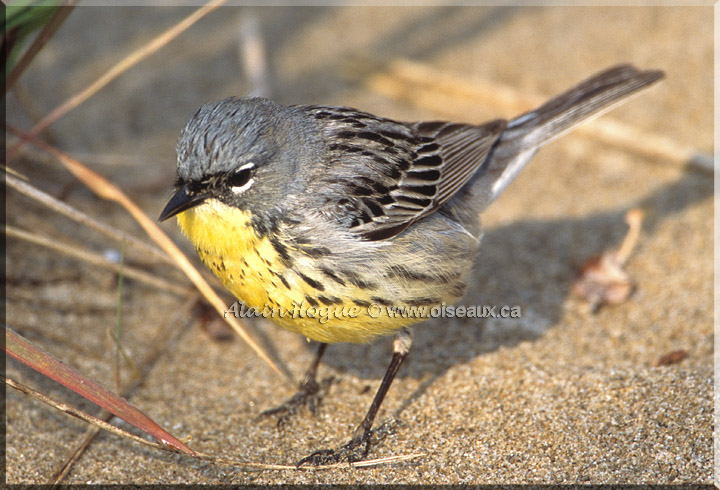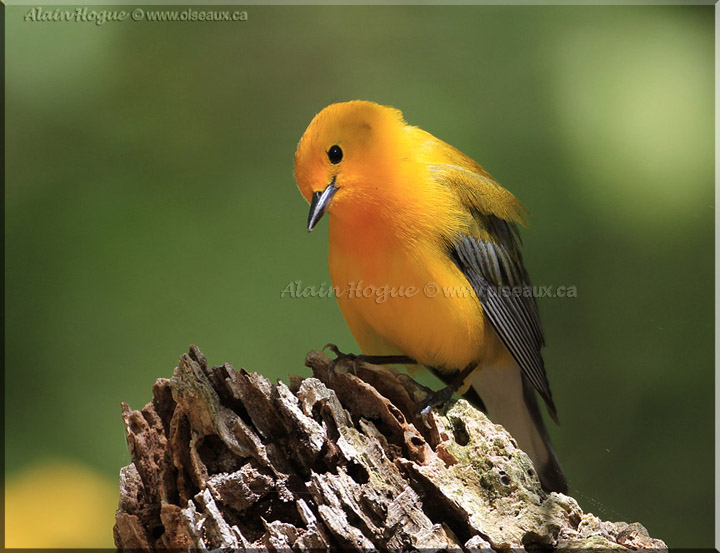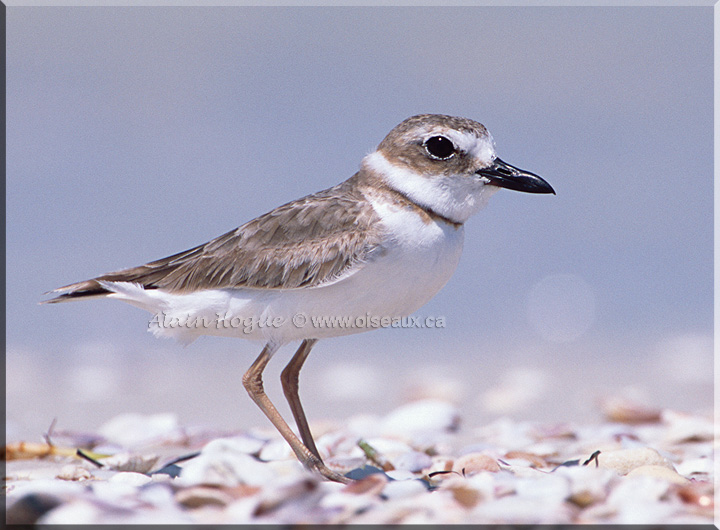|
Status and major threats! |
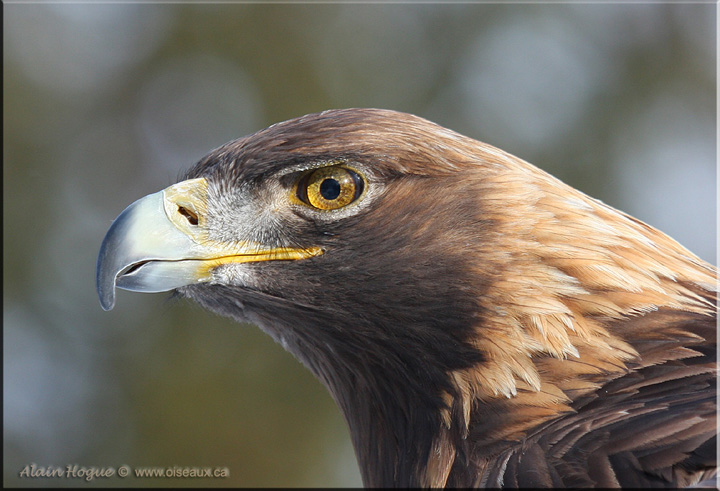
Golden Eagle
Aquila chrysaetos |
Golden Eagle : Vulnerable (provincial).
• The size of the Golden Eagle population in Québec is small and it has a low reproduction rate.
• The species is sensitive to human activities, especially near its nest.
• Several factors threaten this species : slaughter, contamination by toxic chemicals in the wintering areas, habitat loss and disturbance resulting from hydroelectric development.
|
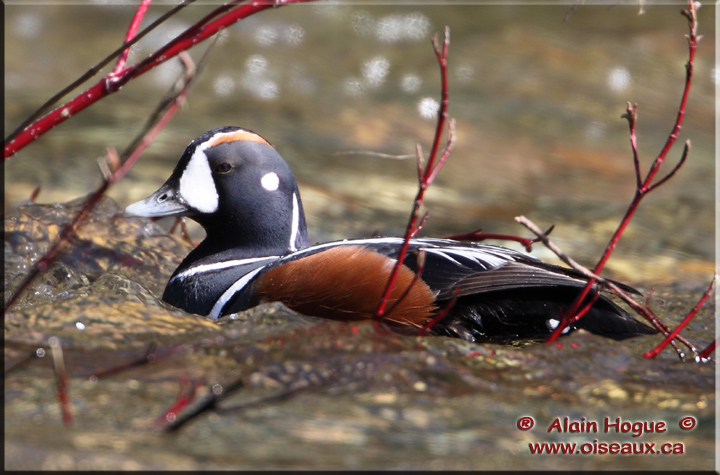
Harlequin Duck (M)
Histrionicus histrionicus |
Harlequin Duck : Vulnerable (provincial) Special concern (federal)
• This duck is rare and it has a low reproduction rate. It uses a very special breeding habitat, areas of whitewater river.
• It is particularly vulnerable in moulting and wintering areas which can be contaminated by oil spills and boat tanks cleaning.
• Threats are the harnessing of rivers and some recreational activities such as rafting.
|
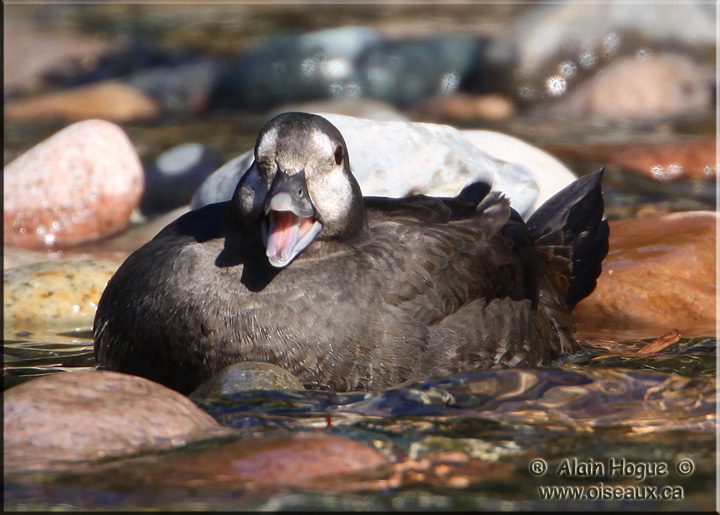
Harlequin Duck (f)
Histrionicus histrionicus |
Harlequin Duck : Vulnerable (provincial) Special concern (federal)
• This duck is rare and it has a low reproduction rate. It uses a very special breeding habitat, areas of whitewater river.
• It is particularly vulnerable in moulting and wintering areas which can be contaminated by oil spills and boat tanks cleaning.
• Threats are the harnessing of rivers and some recreational activities such as rafting.
|
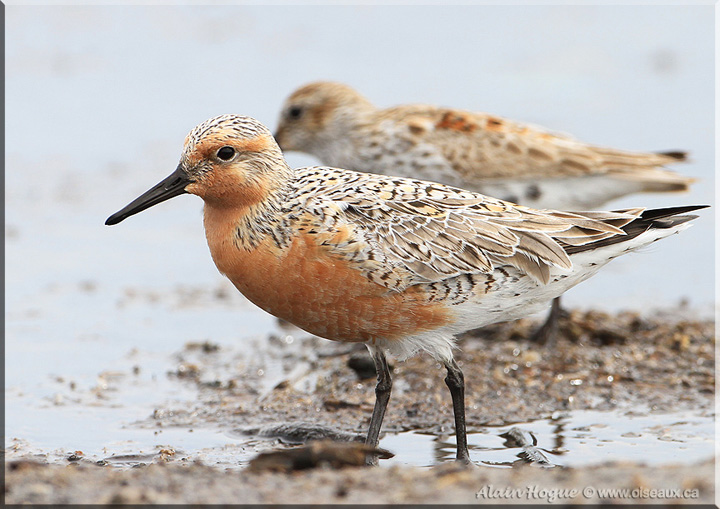
Red Knot
Calidris canutus |
Red Knot : Likely to be designated threatened or vulnerable (provincial) Endangered (federal).
• Knots of the rufa subspecies have been affected by overfishing of horseshoe crab that has been practiced in the Delaware Bay.
• Other threats for Rufa and Islandica subspecies are the reduction of wetland habitat available during migration in eastern North America, the disturbance of birds by humans, the increased number and strength of hurricanes during migration, the effects of climate change, including rising sea levels and altered conditions in the breeding grounds in the Arctic.
|
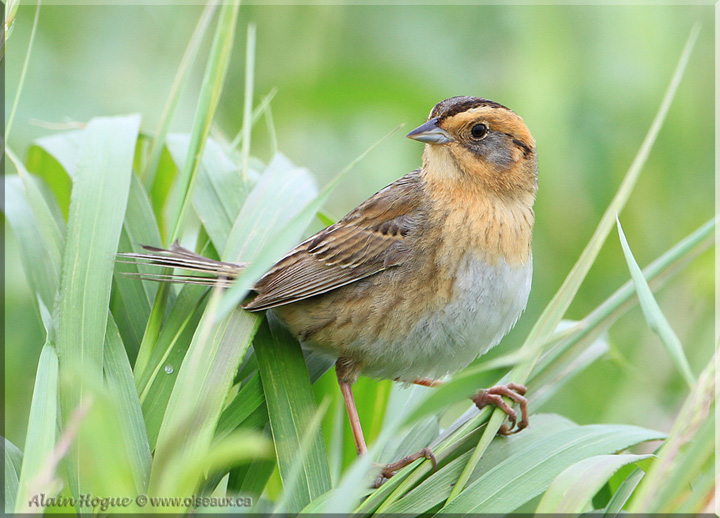
Nelson's Sharp-tailed Sparrow
Ammodramus nelsoni |
Nelson's Sharp-tailed Sparrow : Likely to be designated threatened or vulnerable (provincial).
• The habitat of this sparrow is limited to a thin strip of salty or brackish marshes along the coasts or islands and more rarely freshwater marshes. Recovery of saltmarshes for agricultural purposes and backfill for residential, commercial construction, road and port infrastructure would be responsible for the loss of habitat for this species.
|
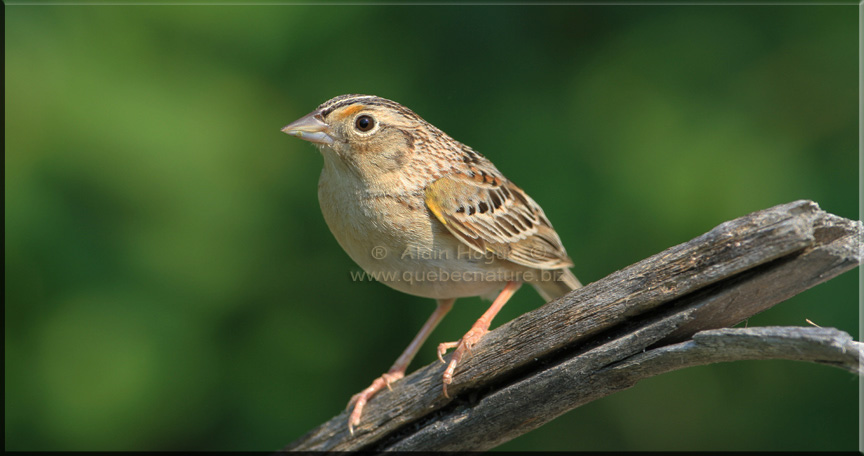
Grasshopper Sparrow
Ammodramus savannarum |
Grasshopper Sparrow : Likely to be designated threatened or vulnerable (provincial).
• In its range, habitat loss associated with reforestation, urbanization, intensive agriculture, hasty haying and the use of pesticides would be prejudicial to him.
• In Québec, Grasshoppers sparrows are more numerous in the Ottawa and Montreal area. Those of the greater Montreal region are more likely to lose their habitat to the benefit of urban and industrial expansion or by changing the types of crops.
|
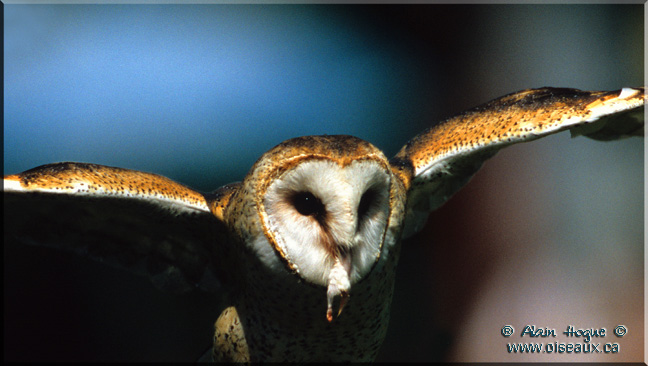
Barn Owl
Tyto alba |
Barn Owl: Likely to be designated threatened or vulnerable (provincial).
|
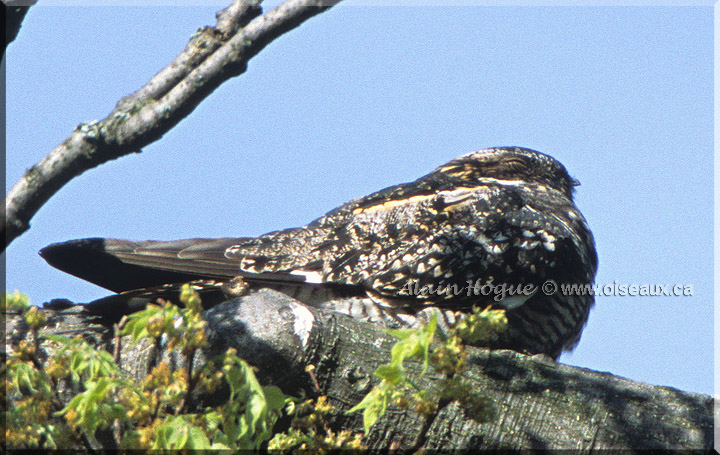
Common Nighthawk
Chordeiles minor |
Common Nighthawk : Likely to be designated threatened or vulnerable (provincial) Threatened (federal).
• The reasons for its decline have not been clearly identified, but it is assumed that there would be a reduction of the food sources (insects) caused by the large-scale use of pesticides. Loss and habitat modification could also be involved, including the reforestation of abandoned farmland, the exploitation of the forests, the fight against fires, intensive agriculture and the gradual reduction of the number of buildings with a flat gravel roof in urban areas.
|
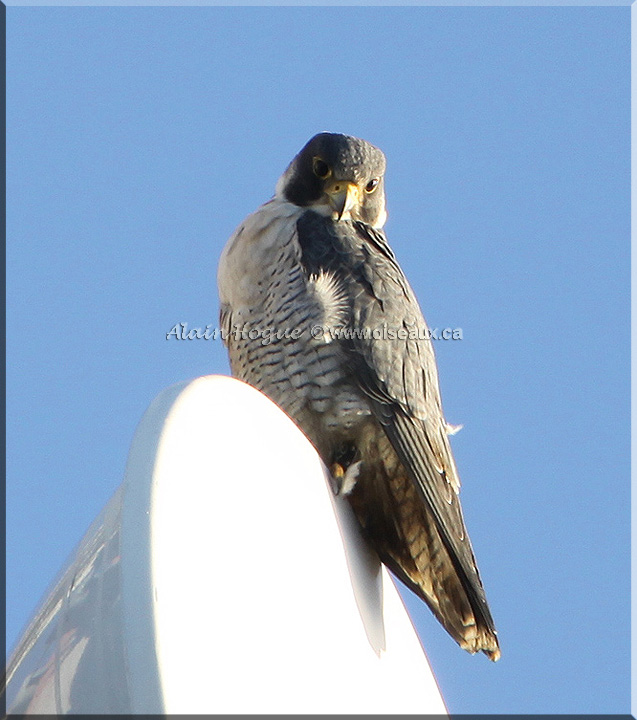
Peregrine Falcon
Falco perigranus |
Peregrine Falcon : Vulnerable (provincial) Special concern (federal).
• The size of the breeding population is still low.
• Organochlorine pesticides, used in some countries of Central America and South America, where many peregrine falcon and their prey migrate, still contaminate many birds.
|
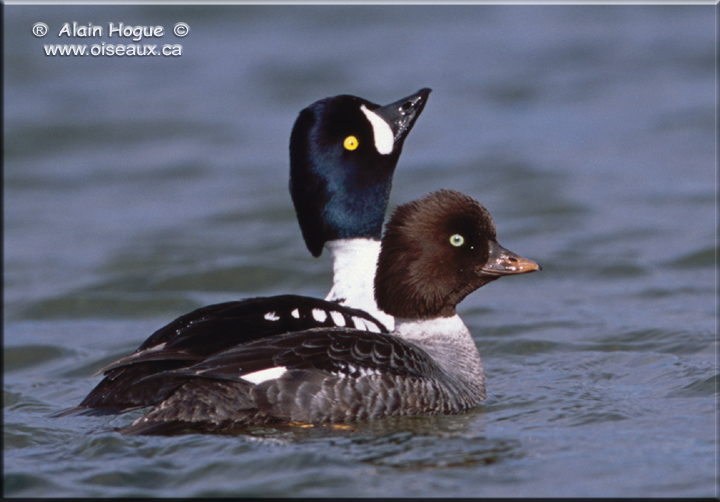
Barrow's Goldeneye
Bucephala islandica |
Barrow's Goldeneye : Vulnerable (provincial) Special concern (federal).
• During the winter, this species is concentrated in a few sites in the Gulf of St. Lawrence, where the risk of oil spills is considered high.
• Logging and fish stocking of fishless lakes are importants threats to the quality of its breeding habitat.
• Although his hunting is prohibited, during hunting season it can be easily confused with the Common Goldeneye (Bucephala clangula).
|

Bobolink
Dolichonyx oryzivorus |
Bobolink : * Threatened COSEPAC
• It is believed that the modernization of farming techniques favoring earlier and more frequent cutting of hay during the breeding season is one of the main threats to Bobolink populations in their breeding area
• Another important cause of population decline is the loss of habitat in American Midwest since the 1950's. This decline is largely attributable to the conversion from traditional agriculture (eg. pastures and hayfields) to intensive cereal crops.
|
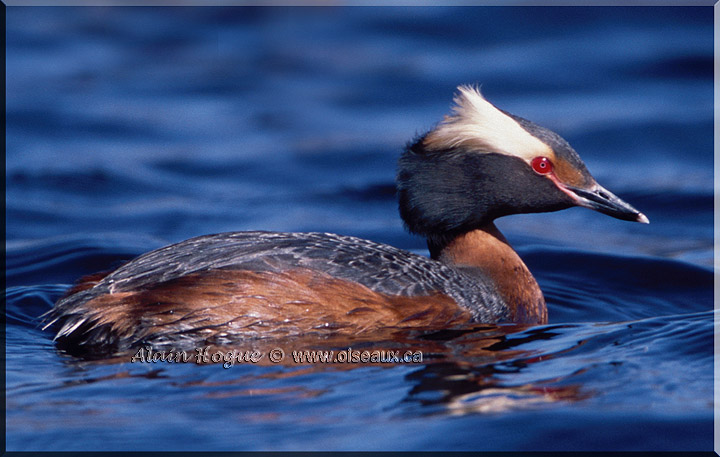
Horned Grebe
Podiceps auritus |
Horned Grebe : Threatened (provincial) Endangered (federal).
• The size of the Québec population is very low, less than 15 breeding pairs.
• Its population and productivity have significantly declined in recent years .
• Besides the natural limiting factors such as predation and climate, new threats have been added in recent years such as disturbance by human and competition from Pied-billed Grebe (Podilymbus podiceps).
|
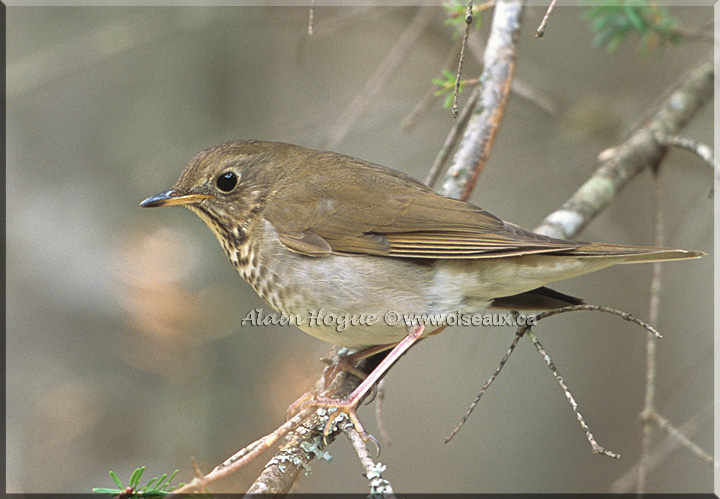
Bicknell's Thrush
Catharus bicknelli |
Bicknell's Thrush : Vulnerable (provincial) Threatened (federal).
• The largest part of the mondial distribution of Bicknell's Thrush is in Quebec and seems to shrink.
• This thrush occupies a very specific breeding habitat.
• Its breeding habitat may be affected by global warming and undergoes significant pressure from the forest industry and the construction of wind turbines.
|
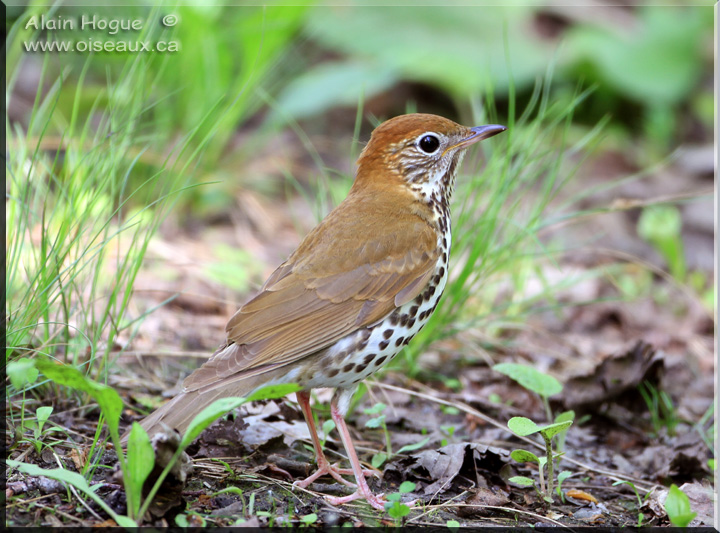
Wood Thrush
Hylocichla mustelina |
Wood Thrush : Threatened (federal).
|
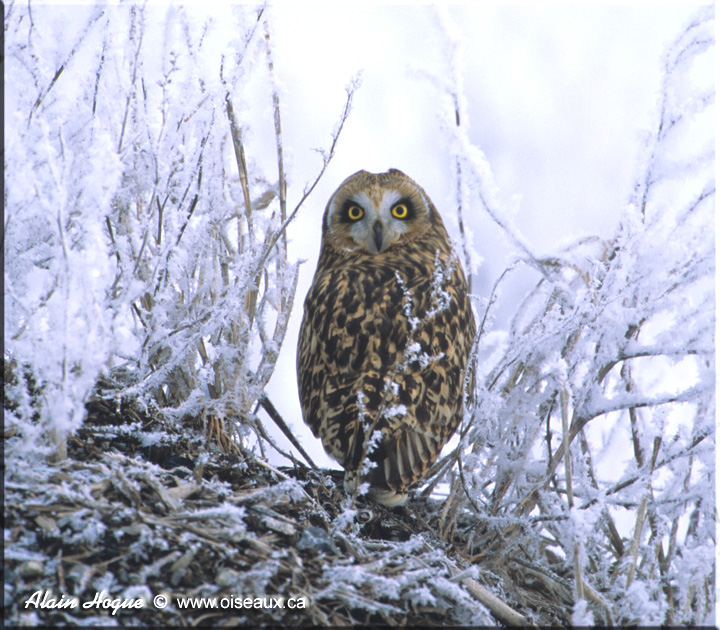
Short-eared Owl
Asio flammeus |
Short-eared Owl : Likely to be designated threatened or vulnerable (provincial) Special concern (federal).
• The population trend in Quebec is not known but it is possible that a decrease has occurred in recent decades. Indeed, the habitat it uses, including the upper part of the marsh, has steadily declined due to land drainage, changes in agricultural practices and industrial and urban sprawl. Ground nesting, it is very exposed to farm machinery and predators.
|
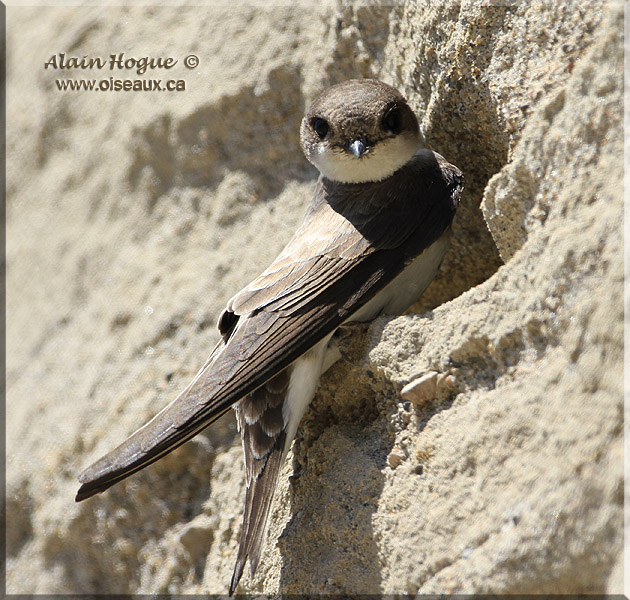
Bank Swallow
Riparia riparia |
Bank Swallow : Threatened (federal).
|
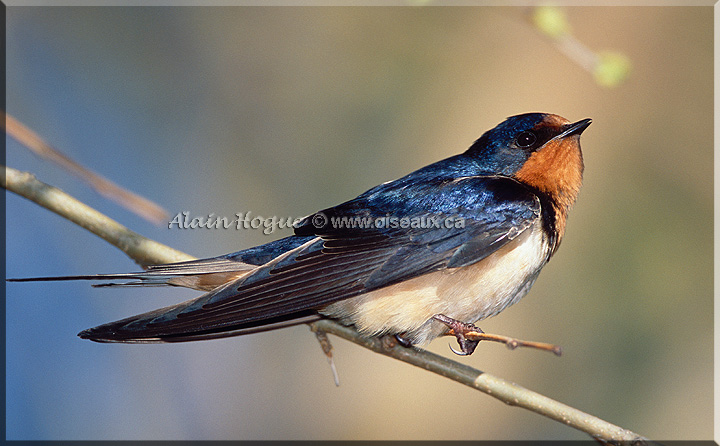
Barn Swallow
Hirundo rustica |
Barn Swallow : Special concern (federal).
|
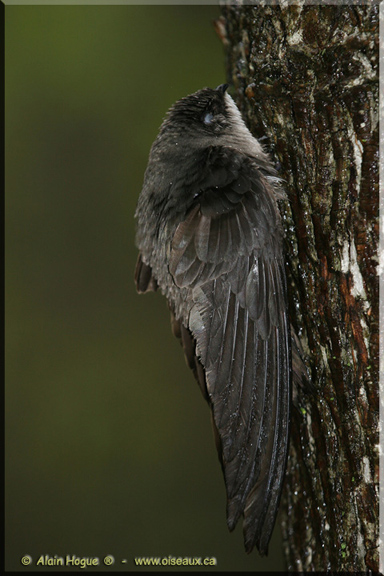
Chimney Swift
Chaetura pelagica |
Chimney Swift : Likely to be designated threatened or vulnerable (provincial) Threatened (federal).
• The main threat factor seems to be the reduction of the number of nesting and resting sites resulting from logging, demolition of old abandoned buildings, and especially the significative drop in the number of adequate and accessible conventional fireplaces, main nesting habitat of the species. In its South American wintering grounds, the species is threatened by intensive logging of the Amazon rainforest. The bad weather also causes many deaths.
|
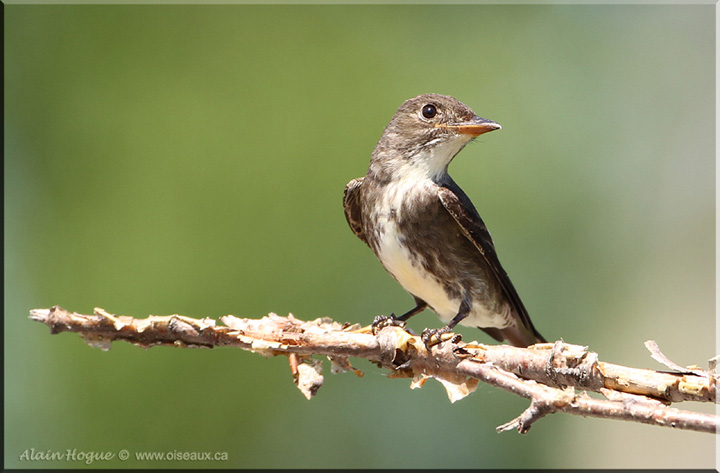
Olive-sided Flycatcher
Contopus cooperi |
Olive-sided Flycatcher : Likely to be designated threatened or vulnerable (provincial) Threatened (federal).
• The causes of its decline are difficult to identify, but they are almost certainly related to the loss and habitat modifications. This bird is usually associated with a very dense vegetation cover, which suggests that it may respond positively to forest management activities such as timber harvesting. However, recent studies suggest that the exploited forests are less suitable for breeding than young forests growing after a fire.
• Modification and loss of habitat in areas where this migratory bird spends the winter could also be significant threats to these populations.
|
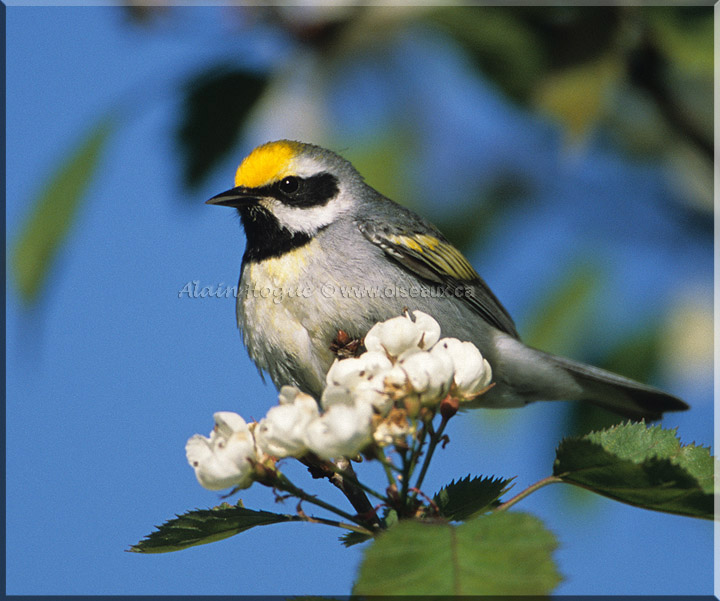
Golden-winged Warbler
Vermivora chrysoptera |
Golden-winged Warbler : Likely to be designated threatened or vulnerable (provincial) Threatened (federal).
• Some factors negatively affect this species such as the loss of wintering habitat, parasitism of nests by the Brown-headed cowbird and competition for some resources with Blue-winged Warbler.
• Because of the changes of the natural environment caused by humans, the breeding of the golden-winged warbler and those of the Blue-winged Warbler would have overlapped. These two species can mate with each other and produce viable hybrids. In addition, it seems that hybrids prefer to choose a Blue-winged Warbler as a partner when it comes to reproduction, thereby disadvantaging the golden-winged warbler.
|

Cerulean Warbler
Dendroica cerulea |
Cerulean Warbler : Threatened (provincial) Endangered (federal).
• In Quebec, this species is at the northern limit of its range and numbers are very low.
• The number of breeding sites identified in Québec is about a dozen and the number of occupied sites seems to decrease.
• Individuals of this species are faithful to their breeding site and their reproductive success is compromised if their habitat is altered or destroyed.
|
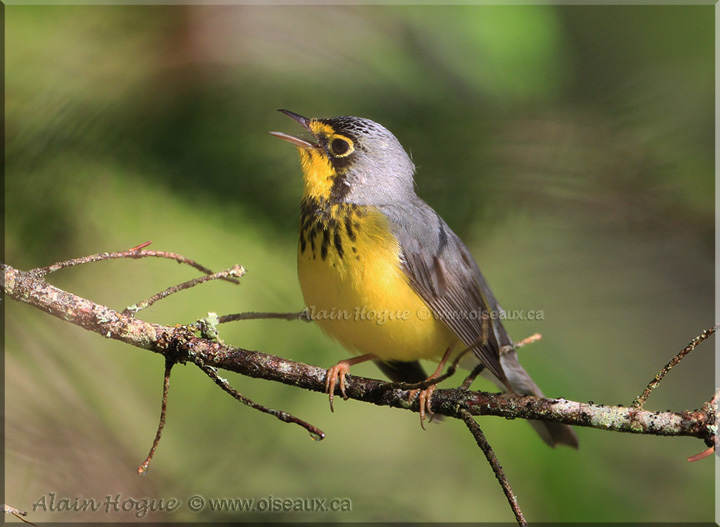
Canada Warbler
Cardellina canadensis |
Canada Warbler : Likely to be designated threatened or vulnerable (provincial) Threatened (federal).
• The factors responsible for the decline of the Canada Warbler have not yet been identified. However, it is believed that the loss and degradation of habitat in the area where this migratory bird spends the winter would mostly contribute to the decline of populations. Forests in the Northern Andes, are the main wintering area of the Canada Warbler and are among the most threatened in the world. Approximately 90% of these forests have disappeared due to agriculture, cutting firewood, crop of illegal drugs and use of non-selective herbicide in order to eliminate these type of cultures. In eastern Canada, habitat loss due to conversion of swamp forests to agricultural activities have contributed to the decline of Canada Warblers.
|

Louisiana Waterthrush
Seiurus motacilla |
Louisiana Waterthrush : Likely to be designated threatened or vulnerable (provincial) Special concern (federal).
• Logging and forest fragmentation are major limiting factors due to the preference of this species of mature forests that provide plenty of shade. These activities take place at an alarming rate throughout the breeding range of this bird in Canada. Drainage of wetlands, construction of reservoirs, fluctuating water levels, pollution and siltation are other factors. Risky migratory flights cause many deaths. Parasitism by Brown-headed Cowbirds also plays a role in the decline of this species.
|
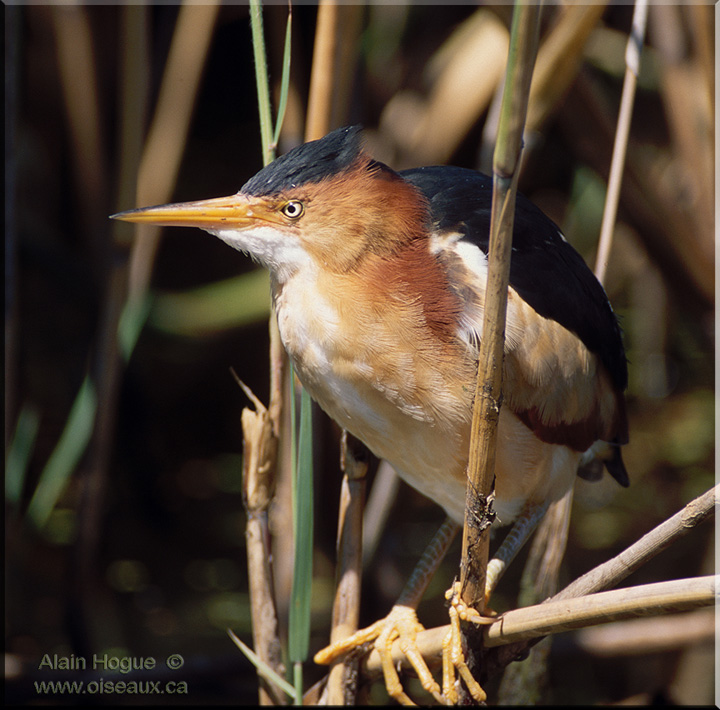
Least Bittern
Ixobrychus exilis |
Least Bittern : Vulnerable (provincial) Threatened (federal).
• The population now seems to be stabilized, but remains at a low level.
• Large wetlands sought by this species are smaller than previously and, despite better protection to these environments for 20 years, loss of wetlands still occur regularly.
|
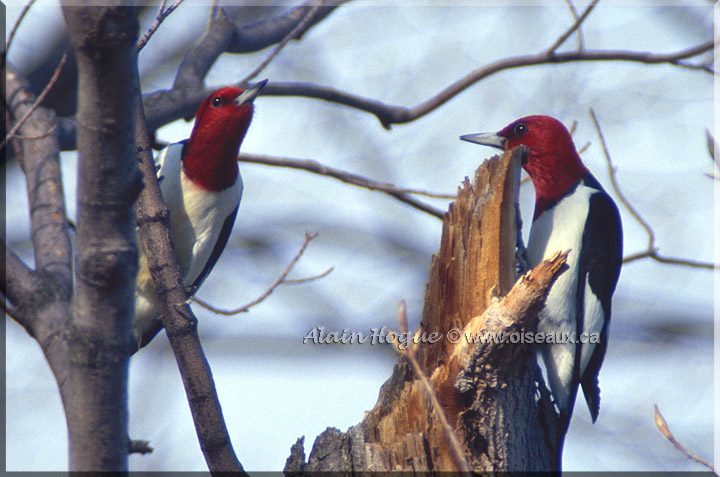
Red-headed Woodpecker
Melanerpes erythrocephalus |
Red-headed Woodpecker : Threatened (provincial) Threatened (federal).
• Southern Quebec is the northeastern boundary of the range of the red-headed woodpecker.
• The scarcity of snags (essential nesting component) and competition from European Starling (Sturnus vulgaris) for nesting sites are among the probable causes of the decline of the Red-headed Woodpecker.
|
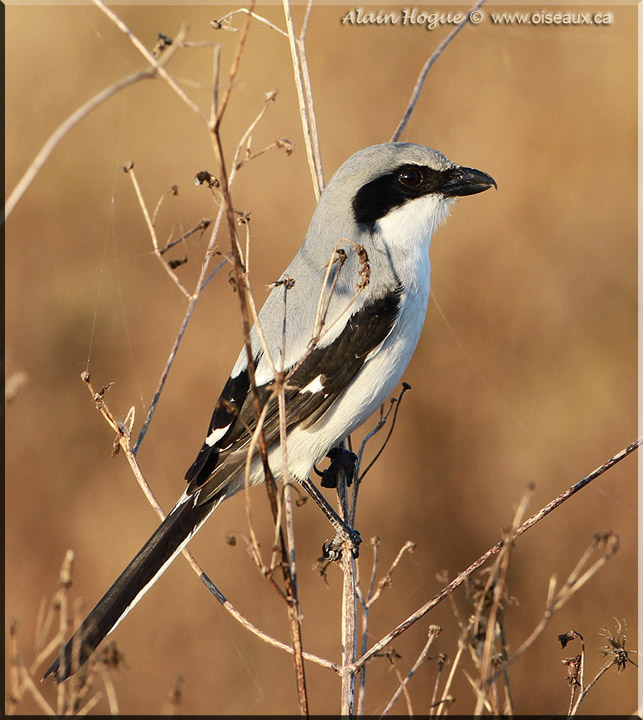
Loggerhead Shrike
Lanius ludovicianus |
Loggerhead Shrike : Threatened (provincial) Endangered (federal).
• This species was relatively common at the beginning of the century in Quebec.
• A few individuals have been observed in recent years.
• The species has suffered a massive decline in Quebec and Eastern North America in recent decades.
|
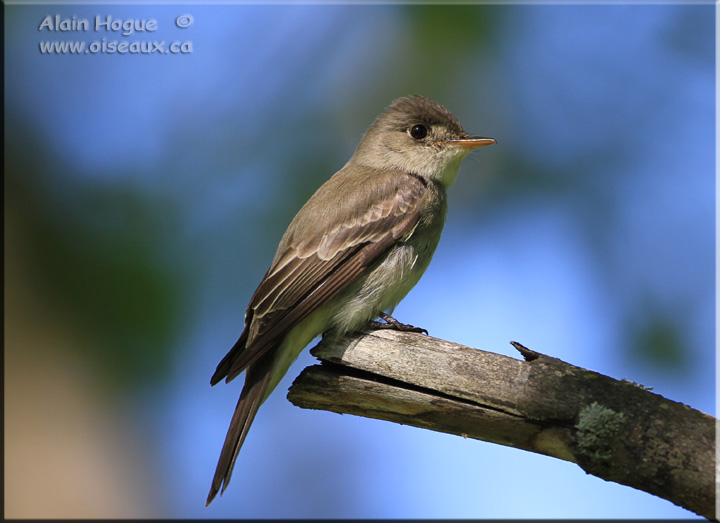
Eastern Wood-pewee
Contopus virens |
Eastern Wood-pewee : Special concern (federal).
|
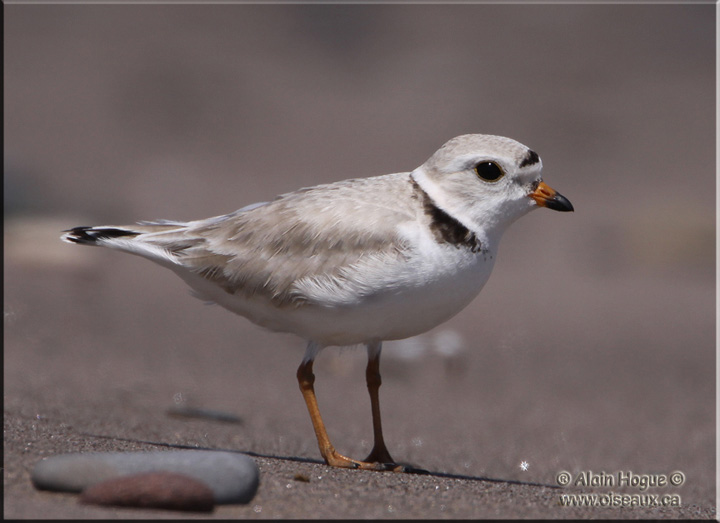
Piping Plover
Charadrius melodus |
Piping Plover : Threatened (provincial) Endangered (federal).
• This species has previously declined in Quebec and is now absent from the Gaspésie and the Côte-Nord Shore.
• The size of the population is low and its presence in Québec is largely limited to the Îles-de-la-Madeleine.
• Piping Plover populations are declining throughout the Atlantic region.
• The most important threat to the survival of this species is the disturbance by human.
|
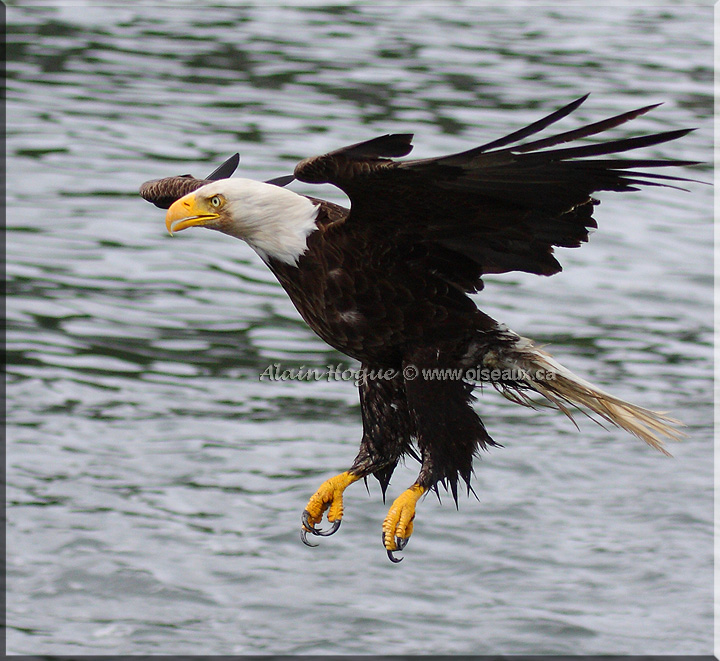
Bald Eagle
Haliaeetus leucocephalus |
Bald Eagle : Vulnerable (provincial).
• Its population is small compared to the situation in the early twentieth century.
• The Bald Eagle is still facing several threats: slaughter by poachers, accidental catches by trappers, contamination by toxic chemicals, disturbance and habitat loss.
|
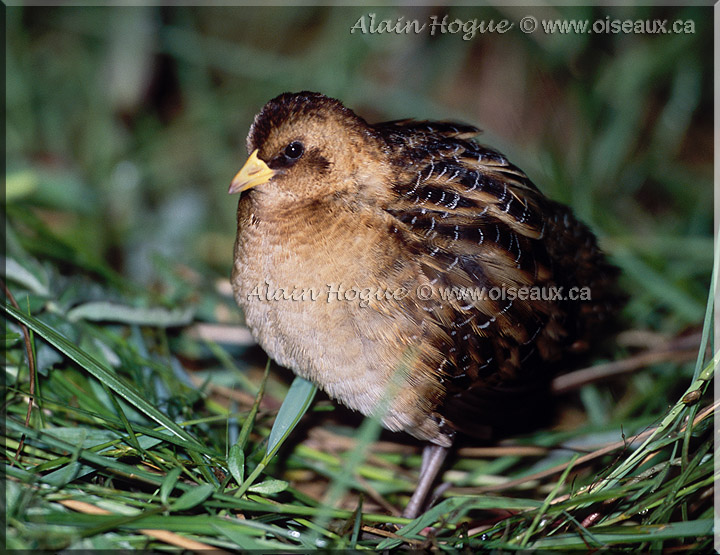
Yellow Rail
Coturnicops noveboracensis |
Yellow Rail : Threatened (provincial) Special concern (federal).
• The number of Yellow Rails are low in Quebec.
• This species occupies the upper part of the marshes, which is most threatened by agricultural activities and encroachments of any kind.
• Wintering areas gradually decrease and are threatened by human activities.
• Québec constituted a good part of the mondial area occupied by this species.
|
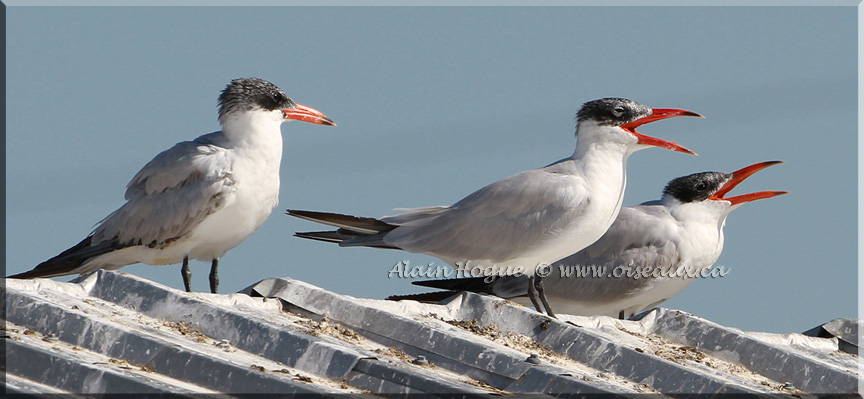
Caspian Tern
Sterna caspia |
Caspian Tern : Threatened (provincial).
• Caspian Tern was never abundant in Quebec. Today it has almost disappeared from its original range limited to a few islands of the north coast of St-Laurent estuary
• Disturbance caused in particular by the collection of eggs. The work of population monitoring also had an important impact on the species.
• There is a strong association between the presence of the Caspian Tern and Ring-billed Gull colonies which can be destroyed for management purposes.
|
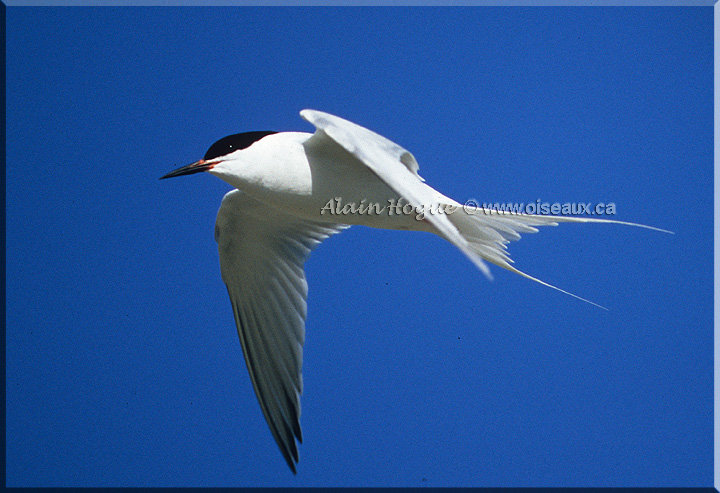
Roseate Tern
Sterna dougallii |
Roseate Tern : Threatened (provincial) Endangered (federal).
• The North American population of Roseate Tern has declined significantly since 1950.
• Surveys conducted in the Îles-de-la-Madeleine reveals a small number of individuals during the nesting period.
• Levels of predation by gulls and foxes are high in Îles-de-la-Madeleine's breeding ground.
• The species has a low fertility.
|
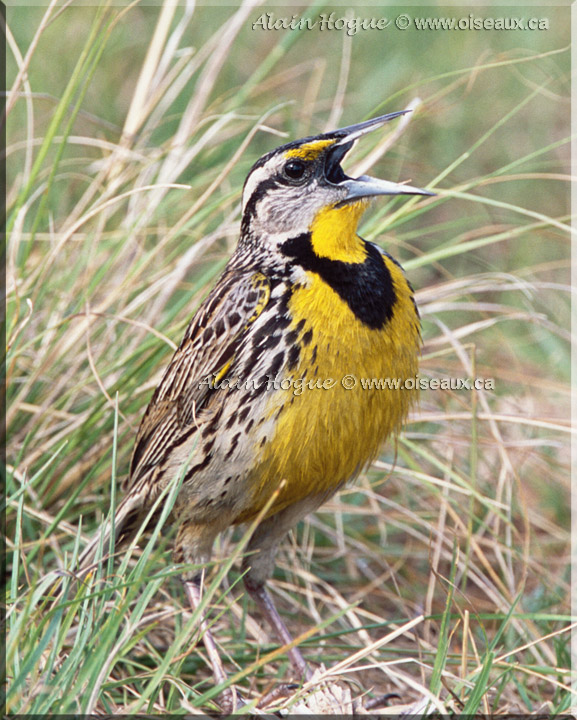
Eastern Meadowlark
Sturnella magna |
Eastern Meadowlark : Threatened (federal).
|
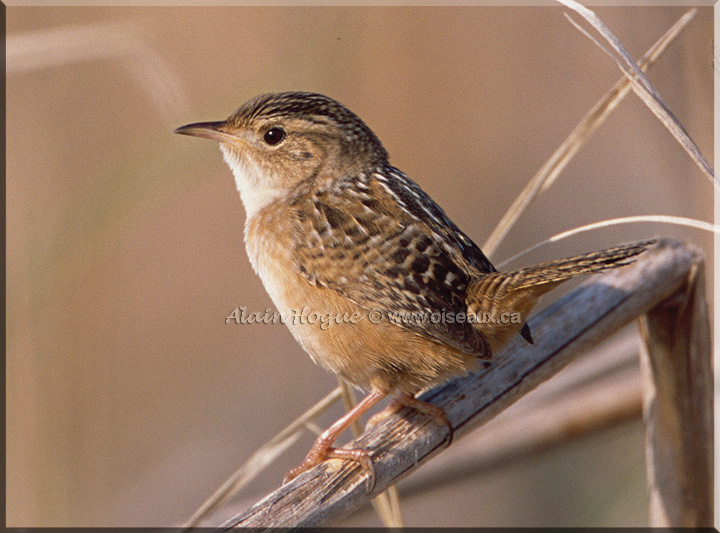
Sedge Wren
Cistothorus platensis |
Sedge Wren : Likely to be designated threatened or vulnerable (provincial).
• Population decline was observed between 1965 and 1979 in the Great Lakes region and in the Northeast United States. In Québec, habitat loss related to intensive agricultural practices and urbanization could be the main limiting factor for the species.
|

 The primary role of these agencies is to identify which species are endangered. In Canada, to carry out this task, the Committee on the Status of Endangered Wildlife in Canada (COSEWIC) has developed a complexed method of evaluation to which are submitted all species of special concern.
It is not an easy task to identify the endangered species . For example, a species may be considered endangered in a specific region, but not elsewhere.
The case of the Horned Grebe is a perfect example. The Committee on the Status of Endangered Wildlife in Canada (COSEWIC) gives it the status of "endangered" on the Québec's territory, while elsewhere in Canada, it is only considered as a "concern" species".
The primary role of these agencies is to identify which species are endangered. In Canada, to carry out this task, the Committee on the Status of Endangered Wildlife in Canada (COSEWIC) has developed a complexed method of evaluation to which are submitted all species of special concern.
It is not an easy task to identify the endangered species . For example, a species may be considered endangered in a specific region, but not elsewhere.
The case of the Horned Grebe is a perfect example. The Committee on the Status of Endangered Wildlife in Canada (COSEWIC) gives it the status of "endangered" on the Québec's territory, while elsewhere in Canada, it is only considered as a "concern" species".

